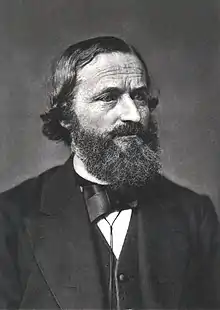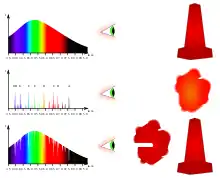Gustav Kirchhoff | |
|---|---|
 | |
| Born | Gustav Robert Kirchhoff 12 March 1824 |
| Died | 17 October 1887 (aged 63) |
| Nationality | Prussian (1824–1871) German (1871–1887) |
| Alma mater | University of Königsberg |
| Known for | Kirchhoff's circuit laws Kirchhoff's law of thermal radiation Kirchhoff's laws of spectroscopy Kirchhoff's law of thermochemistry |
| Awards | Rumford medal (1862) Davy Medal (1877) Matteucci Medal (1877) Janssen Medal (1887) |
| Scientific career | |
| Fields | Physics Chemistry |
| Institutions | University of Berlin University of Breslau University of Heidelberg |
| Doctoral advisor | Franz Ernst Neumann |
| Notable students | Loránd Eötvös Edward Nichols Gabriel Lippmann Dmitri Ivanovich Mendeleev Max Planck Jules Piccard Max Noether Heike Kamerlingh Onnes Ernst Schröder |
Gustav Robert Kirchhoff (German: [ˈkɪʁçhɔf]; 12 March 1824 – 17 October 1887) was a German physicist who contributed to the fundamental understanding of electrical circuits, spectroscopy, and the emission of black-body radiation by heated objects.[1][2]
He coined the term black-body radiation in 1860. Several different sets of concepts, concerning diverse subjects such as black-body radiation and spectroscopy, electrical circuits, and thermochemistry, are named "Kirchhoff's laws" after him. The Bunsen–Kirchhoff Award for spectroscopy is named after him and his colleague, Robert Bunsen.
Life and work
Gustav Kirchhoff was born on 12 March 1824 in Königsberg, Prussia, the son of Friedrich Kirchhoff, a lawyer, and Johanna Henriette Wittke.[3] His family were Lutherans in the Evangelical Church of Prussia. He graduated from the Albertus University of Königsberg in 1847 where he attended the mathematico-physical seminar directed by Carl Gustav Jacob Jacobi,[4] Franz Ernst Neumann and Friedrich Julius Richelot. In the same year, he moved to Berlin, where he stayed until he received a professorship at Breslau. Later, in 1857, he married Clara Richelot, the daughter of his mathematics professor Richelot. The couple had five children. Clara died in 1869. He married Luise Brömmel in 1872.[5]

Kirchhoff formulated his circuit laws, which are now ubiquitous in electrical engineering, in 1845, while still a student. He completed this study as a seminar exercise; it later became his doctoral dissertation. He was called to the University of Heidelberg in 1854, where he collaborated in spectroscopic work with Robert Bunsen. In 1857, he calculated that an electric signal in a resistanceless wire travels along the wire at the speed of light.[6][7] He proposed his law of thermal radiation in 1859, and gave a proof in 1861. Together Kirchhoff and Bunsen invented the spectroscope, which Kirchhoff used to pioneer the identification of the elements in the Sun, showing in 1859 that the Sun contains sodium. He and Bunsen discovered caesium and rubidium in 1861.[8] At Heidelberg he ran a mathematico-physical seminar, modelled on Franz Ernst Neumann's, with the mathematician Leo Koenigsberger. Among those who attended this seminar were Arthur Schuster and Sofia Kovalevskaya.
He contributed greatly to the field of spectroscopy by formalizing three laws that describe the spectral composition of light emitted by incandescent objects, building substantially on the discoveries of David Alter and Anders Jonas Ångström. In 1862, he was awarded the Rumford Medal for his researches on the fixed lines of the solar spectrum, and on the inversion of the bright lines in the spectra of artificial light.[lower-alpha 1] In 1875 Kirchhoff accepted the first chair dedicated specifically to theoretical physics at Berlin.
He also contributed to optics, carefully solving the wave equation to provide a solid foundation for Huygens' principle (and correct it in the process).[10][11]
In 1864, he was elected as a member of the American Philosophical Society.[12]
In 1884, he became foreign member of the Royal Netherlands Academy of Arts and Sciences.[13]
Kirchhoff died in 1887, and was buried in the St Matthäus Kirchhof Cemetery in Schöneberg, Berlin (just a few meters from the graves of the Brothers Grimm). Leopold Kronecker is buried in the same cemetery.
Kirchhoff's circuit laws
Kirchhoff's first law is that the algebraic sum of currents in a network of conductors meeting at a point (or node) is zero. The second law is that in a closed circuit, the directed sums of the voltages in the system is zero.
Kirchhoff's three laws of spectroscopy

- A solid, liquid, or dense gas excited to emit light will radiate at all wavelengths and thus produce a continuous spectrum.
- A low-density gas excited to emit light will do so at specific wavelengths, and this produces an emission spectrum.
- If light composing a continuous spectrum passes through a cool, low-density gas, the result will be an absorption spectrum.
Kirchhoff did not know about the existence of energy levels in atoms. The existence of discrete spectral lines was known since Fraunhofer discovered them in 1814. And that the lines formed a discrete mathematical pattern was described by Johann Balmer in 1885. Joseph Larmor explained the splitting of the spectral lines in a magnetic field known as the Zeeman Effect by the oscillation of electrons.[14][15] But these discrete spectral lines were not explained as electron transitions until the Bohr model of the atom in 1913, which helped lead to quantum mechanics.
Kirchhoff's law of thermal radiation
It was Kirchhoff's law of thermal radiation in which he proposed an unknown universal law for radiation that led Max Planck to the discovery of the quantum of action leading to quantum mechanics.
Kirchhoff's law of thermochemistry
Kirchhoff showed in 1858 that, in thermochemistry, the variation of the heat of a chemical reaction is given by the difference in heat capacity between products and reactants:
- .
Integration of this equation permits the evaluation of the heat of reaction at one temperature from measurements at another temperature.[16][17]
Works
- Gesammelte Abhandlungen (in German). Leipzig: Johann Ambrosius Barth. 1882.
- Vorlesungen über Electricität und Magnetismus (in German). Leipzig: Benedictus Gotthelf Teubner. 1891.
- Vorlesungen über mathematische Physik. 4 vols., B. G. Teubner, Leipzig 1876–1894.
- Vol. 1: Mechanik. 1. Auflage, B. G. Teubner, Leipzig 1876 (online).
- Vol. 2: Mathematische Optik. B. G. Teubner, Leipzig 1891 (Herausgegeben von Kurt Hensel, online).
- Vol. 3: Electricität und Magnetismus. B. G. Teubner, Leipzig 1891 (Herausgegeben von Max Planck, online).
- Vol. 4: Theorie der Wärme. B. G. Teubner, Leipzig 1894, Herausgegeben von Max Planck[18]
See also
- Kirchhoff equations
- Kirchhoff integral theorem
- Kirchhoff matrix
- Kirchhoff stress tensor
- Kirchhoff transformation
- Kirchhoff's diffraction formula
- Kirchhoff's perfect black bodies
- Kirchhoff's theorem
- Kirchhoff–Helmholtz integral
- Kirchhoff–Love plate theory
- Piola–Kirchhoff stress
- Saint Venant–Kirchhoff model
- Stokes–Kirchhoff attenuation formula
- Circuit rank
- Computational aeroacoustics
- Flame emission spectroscopy
- Spectroscope
- Kirchhoff Institute of Physics
- List of German inventors and discoverers
Notes
- ↑ Marshall, James L.; Marshall, Virginia R. (2008). "Rediscovery of the Elements: Mineral Waters and Spectroscopy" (PDF). The Hexagon: 42–48. Retrieved 31 December 2019.
- ↑ Waygood, Adrian (19 June 2013). An Introduction to Electrical Science. Routledge. ISBN 9781135071134.
- ↑ Kondepudi, Dilip; Prigogine, Ilya (5 November 2014). Modern Thermodynamics: From Heat Engines to Dissipative Structures. John Wiley & Sons. p. 288. ISBN 9781118698709.
- ↑ Hockey, Thomas (2009). "Kirchhoff, Gustav Robert". The Biographical Encyclopedia of Astronomers. Springer Nature. ISBN 978-0-387-31022-0. Retrieved 22 August 2012.
- ↑ "Gustav Robert Kirchhoff – Dauerausstellung". Kirchhoff-Institute for Physics. Retrieved 18 March 2016.
Am 16. August 1857 heiratete er Clara Richelot, die Tochter des Königsberger Mathematikers ... Frau Clara starb schon 1869. Im Dezember 1872 heiratete Kirchhoff Luise Brömmel.
- ↑ Kirchhoff, G. (1857). "On the motion of electricity in wires". Philosophical Magazine. 13: 393–412.
- ↑ Graneau, P.; Assis, A.K.T. (1994). "Kirchhoff on the motion of electricity in conductors" (PDF). Apeiron. 1 (19): 19–25. Archived (PDF) from the original on 8 January 2006.
- ↑ Weeks, Mary Elvira (1956). The discovery of the elements (6th ed.). Easton, PA: Journal of Chemical Education.
- ↑ Asimov, Isaac The Secret of the Universe (Oxford University Press, 1992) p. 109
- ↑ B.B. Baker and E.T. Copson, The Mathematical Theory of Huygens' Principle (Oxford University Press, 1939), pp. 36–38.
- ↑ D. Miller, "Huygens's wave propagation principle corrected", Opt. Lett. 16, 1370–1372 (1991)
- ↑ "APS Member History". search.amphilsoc.org. Retrieved 16 April 2021.
- ↑ "G.R. Kirchhoff (1824–1887)". Royal Netherlands Academy of Arts and Sciences. Retrieved 22 July 2015.
- ↑ Histories of the Electron: The Birth of Microphysics edited by Jed Z. Buchwald, Andrew Warwick
- ↑ Larmor, Joseph (1897), , Philosophical Transactions of the Royal Society, 190: 205–300, Bibcode:1897RSPTA.190..205L, doi:10.1098/rsta.1897.0020
- ↑ Laidler K.J. and Meiser J.H., "Physical Chemistry" (Benjamin/Cummings 1982), p.62
- ↑ Atkins P. and de Paula J., "Atkins' Physical Chemistry" (8th edn, W.H. Freeman 2006), p.56
- ↑ Merritt, Ernest (1895). "Review of Vorlesungen über mathematische Physik. Vol. IV. Theorie der Wärme by Gustav Kirchhoff, edited by Max Planck". Physical Review. American Physical Society: 73–75.
Gustav Robert Kirchhoff, “IV. Ueber das Verhältniß zwischen dem Emissionsvermögen und dem Absorptionsvermögen der Körper für Wärme und Licht,” Annalen der Physik 185(2), 275-301 (1860). (coinage of term “blackbody”) [On the relationship between the emissivity and the absorptivity of bodies for heat and light]
References
- Warburg, E. (1925). "Zur Erinnerung an Gustav Kirchhoff". Die Naturwissenschaften. 13 (11): 205. Bibcode:1925NW.....13..205W. doi:10.1007/BF01558883. S2CID 30039558.
- Stepanov, B. I. (1977). "Gustav Robert Kirchhoff (on the ninetieth anniversary of his death)". Journal of Applied Spectroscopy. 27 (3): 1099. Bibcode:1977JApSp..27.1099S. doi:10.1007/BF00625887. S2CID 95181496.
- Everest, A S (1969). "Kirchhoff-Gustav Robert 1824–1887". Physics Education. 4 (6): 341. Bibcode:1969PhyEd...4..341E. doi:10.1088/0031-9120/4/6/304. S2CID 250765281.
- Kirchhoff, Gustav (1860). "Ueber die Fraunhoferschen Linien". Monatsberichte der Königliche Preussische Akademie der Wissenschaften zu Berlin: 662–665. ISBN 978-1-113-39933-5. HathiTrust full text. Partial English translation available in Magie, William Francis, A Source Book in Physics (1963). Cambridge: Harvard UP. p. 354-360.
Further reading
- Gustav Kirchhoff at the Mathematics Genealogy Project
- O'Connor, John J.; Robertson, Edmund F., "Gustav Kirchhoff", MacTutor History of Mathematics Archive, University of St Andrews
- Weisstein, Eric Wolfgang (ed.). "Kirchhoff, Gustav (1824–1887)". ScienceWorld.
- Klaus Hentschel: Gustav Robert Kirchhoff und seine Zusammenarbeit mit Robert Wilhelm Bunsen, in: Karl von Meyenn (Hrsg.) Die Grossen Physiker, Munich: Beck, vol. 1 (1997), pp. 416–430, 475–477, 532–534.
- Klaus Hentschel: Mapping the Spectrum. Techniques of Visual Representation in Research and Teaching, Oxford: OUP, 2002.
- Kirchhoff's 1857 paper on the speed of electrical signals in a wire
 Texts on Wikisource:
Texts on Wikisource:
- "Kirchhoff, Gustav Robert". Encyclopedia Americana. 1920.
- "Kirchhoff, Gustav Robert". The New Student's Reference Work. 1914.
- "Kirchhoff, Gustav Robert". Encyclopædia Britannica (11th ed.). 1911.
- "Kirchhoff, Gustav Robert". New International Encyclopedia. 1905.
- "Sketch of Gustav Robert Kirchhoff". Popular Science Monthly. Vol. 33. May 1888.
- "Kirchhoff, Gustav Robert". The American Cyclopædia. 1879.
External links
 Quotations related to Gustav Kirchhoff at Wikiquote
Quotations related to Gustav Kirchhoff at Wikiquote Media related to Gustav Robert Kirchhoff at Wikimedia Commons
Media related to Gustav Robert Kirchhoff at Wikimedia Commons- Open Library